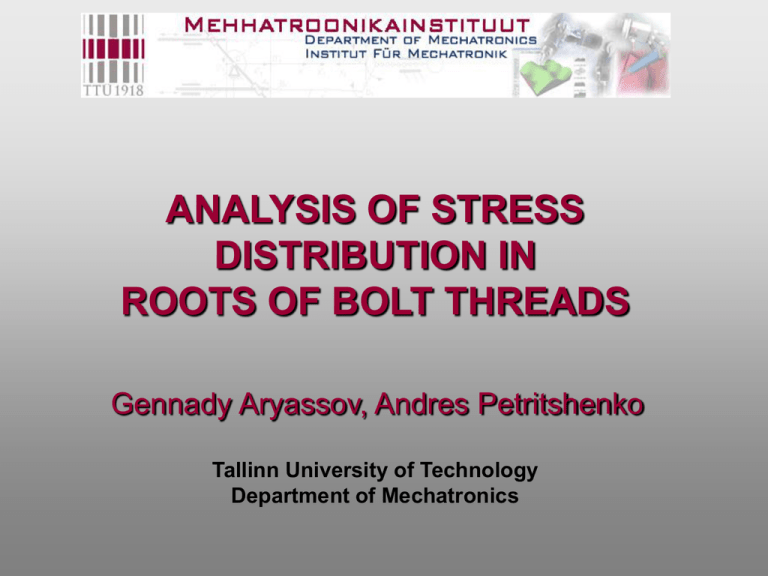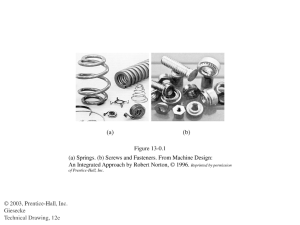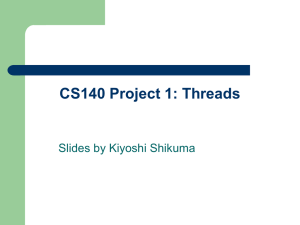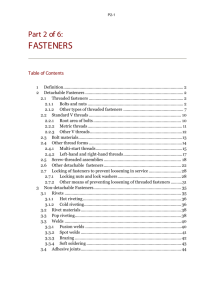F(i)
advertisement

ANALYSIS OF STRESS
DISTRIBUTION IN
ROOTS OF BOLT THREADS
Gennady Aryassov, Andres Petritshenko
Tallinn University of Technology
Department of Mechatronics
1. Motivation
When threaded joints are subjected to an axial load a stress
concentration in thread roots take place (Fig.1).
Under ideal conditions, the tension in the screw (bolt) and the
compression in the nut (such scheme of loading is designated as BoltNut I (Fig.1a) should be reduced uniformly starting from full load at the
first contact between screw and nut threads.
The same condition is required for other schemes of loading when the
screw is compressed and the nut is tensioned (Bolt-Nut II) (Fig.1b) or
both screw and nut are tensioned (Tightener) (Fig.1c) or compressed
(Post) (Fig.1d).
F
F/2
F/2
F
q(z)
q(z)
F(i)
q(z)
q(z)
F/2
a)
F/2
F/2
F
F/2
b)
c)
Fig. 1
F
d)
F/2
F/2
It is well known that axial load acting on a bolt is distributed between
threads of threaded joints extremely nonuniformly.
So for standard metric, trapezoidal, rectangular and buttress threads,
having nominal diameter 10mm with five working threads, the loads on
the most loaded threads are 33,1; 48,1 and 51,9 percents of axial load
on a bolt accordingly.
For threaded joints, working within dynamic loads or made of sensitive
materials to stress concentration, stresses in the root of the first
working threads can considerably exceed nominal tensile stresses in a
cross section of bolt shank, and this fact considerably reduces fatigue
life of the threaded joints.
Russian scientist N. Zhukovski first proposed solution of nonuniform
distribution of axial load between threads of threaded connections in
1902. He idealized that roots of threads are independent to each other
and nonuniform distribution of axial load between independent roots of
thread occur due to shear only.
More accurate solution of nonuniform distribution of axial load between
roots of real threaded connections was reported by (Birger & Iosilevich,
1973). Roots of threads were considered as continuous and actual
stress distribution in thread roots was defined by force flows, which
cause tension of the bolt body, as well as bending and shearing of the
threads. In this case, compatibility of displacements between roots of
threads of threaded connections was used as basic assumption for
solution.
Solution of nonuniform distribution of axial load in some idealized
threaded connections by finite element method was introduced by
(Marujama, 1973, 1974, 1976). Later in their studies (Strizhak et
al.,1999 and Aryassov et al., 2000) have shown that , that stress
distribution and stress concentration in threaded connections by existing
calculation schemes depends upon loading schemes mainly and so can
not be extended to every kind of thread connections.
As it has seen in limited overview, a lot of contribution is made to
develop precise calculation schemes for stress distribution in thread
connections. Most of existing calculation schemes is idealized and
don’t taking into account thread fit or tolerances in thread connections,
which plays a vital role in precision of calculations. Due to thread fit or
tolerances between the bolt and nut threads, solution of real stress
distribution and stress concentration in thread connection is more
complicated.
In this paper more general calculation scheme of
stress distribution and stress concentration is
proposed. Proposed calculation scheme takes into
account thread fit in thread connections and based on
more exact models of finite element method. Theory to
use extended approach in calculations is given as well.
2. Basis for calculations
As far as threads in threads connections can be considered as a group
of small recesses, in which circular stresses can be ignored in
comparison with the axial and radial stresses, a task of calculation of
threaded joints can be reduced to axisymmetric task of the elasticity
theory.
In process of calculation by the finite element method, a detail is
divided into a suitable number of the finite element, connected to each
other at nodal points. Relation between displacements of nodal points
and acting forces is described by
[K] {u} = {f}
(1)
where
[K] – stiffness matrix, {u} and {f} – vector-columns of nodal
displacements and forces (external and contact forces).
z
q6
Thread connection is meshed by
square element with 16 degrees of
freedom (Fig.2). Every nodal point
has two linear and two angular
generalized displacements.
q14
q15
q7
q5
q13
q8
q16
b
q4
q12
q3
q9
r
q1
q2
q11
a
q10
Fig.2
Stiffness matrix of square element is obtained by variation of potential energy
of body deformation, which is described by
v 2 w 2 v w v w 1 v 2 w 2
U G 1 2 d S (2)
S
y z y z z y 2 z y
where v and w - components of displacements on the y and z - axes,
μ – Poisson’s ratio, G – shear modulus,
2
1
and 2
- non-dimensional coefficients
1
1 2
1 2
Displacements inside the square element are to be approximated by
interpolation polynomials as follows
w r , z
v r , z 1 2 z 3 z 2 4 z 3 5 6r ,
7
8r 9r 2 10r 3 11 12 z
(3)
where
- unknown coefficients of interpolation polynomials,
z and r - local coordinate axes.
Displacements inside the elements with respect of generalized coordinates are
v r , z Niv qiv ;
i 1,4,5,8,9,12,13,16
(4)
w r , z Nkwqkw ; k 2,3,6,7,10,11,14,15
N iv and N w - interpolation shape functions, according to kinematical relations
k
by theory of elasticity.
where
Elements of stiffness matrix can be found by substituting
equation (4) to expression of potential energy (2) and following
variation (2) with respect of generalized coordinates qik .
Mathematical model for determination of load distribution in a contact zone between
threads is represented in Fig. 3.
a)
?)
Undeformed
r
O
R1
r1
O1
C1
r
R1 R2
r1
C2
r2
O1
r2
r2
O2
2
O2
z,
z1,z2
1
r1
C1 C2
R2
O
F
r1
r2
Deformed
b)
F
z,
z1,z2
Fig. 3. Interaction between bolt and nut threads
For determination of load distribution compatibility equations of displacements and
equilibrium are used. The equation of equilibrium for one thread component can be
expressed as
n
F pi dAk
(5)
i 1Ak
where
pi - contact pressure, i - number of thread root in contact, Ai - area of contact zone.
Compatibility equation of displacement can be expressed by contact
points C1 and C2 between bolt and nut thread as represented in Fig. 3
and are
1 2 2 1
(6)
where
1 OO1* OO1 and 2 OO2* OO2
in global coordinate system,
- kinematical displacements
1 r 1* r 1 and 2 r 2* r 2 - displacements in local coordinate
systems.
For determination of the contact pressure in finite element model,
delta function is used.
The kinematical displacements represented in Eq. (6) are projected to
the normal of the working plane of roots of thread using delta function
can be expressed as
w
u
p
t
K
cos
K
sin
ik k 1 jk
1 jk
2
2
k j 1
N
w
F G1 j cos G1uj sin
2
2
w
u
K
cos
K
sin
2 jk
2 jk
2
2
w
u
G
cos
G
sin
2j
2j
2
2
n
n
1 2
(7)
where
K 1wjk , K 1ujk , K 2wjk , K u2 jk - influence function of contact pressure for bolt
and nut threads,
G1wj , G1uj , G 2wj , G u2 j
- influence function of external forces for bolt
and nut threads,
t k - width of k’s block of shape function of contact pressure,
- angle between roots of thread.
3. Calculation results
Thread M10 was used as calculation model and it was
subjected to uniformly distributed stress 1=10 МPа on the
bolt cross-section. Modulus of elasticity Е = 200 GPа,
Poisson's ratio = 0.3 and influence of temperature and
gravity were not considered. Model assumes unmovable
hinged nodes on an axis r, passing within of free bolt edge,
which corresponds to constrained deformation conditions
appearing, when there are free threads of the bolt over the
nut.
Results of calculation of load distribution on threads are
given in Table 1 and are compared with calculation
results according (Birger & Iosilevich, 1973), (Marujama,
1976) and to the ANSYS program, which used a standard
triangular element with six nodal points.
Table 1. Contact load (pressure) in roots of thread
No
of
root
1
2
3
4
5
Load on the thread in per set of F
Present Experimental Analytical ANSYS
calcu(Marujama,
(Birger,
program
lation
1976)
1973)
40.93
37.35
36.50
36.48
23.12
22.83
23.75
21.97
15.07
16.78
16.50
15.64
11.56
13.40
12.75
13.05
9.32
9.64
10.50
10.82
Results of the present calculation of stress distribution (MPa) in
roots of thread are represented in Fig. 4.
1 8
M10
10 ,4
18 ,6
2 2,1
54 ,6
97 ,8
1 2,2
1 4,8
20 ,1
8
27 ,6
4 1,3
c 2 0 MP a
Fig. 4. Stress distribution in roots of thread
3-D model of the finite element with 20 degrees of
freedom (in every nodal point are 5 displacements –
two in-plane, one transverse and two angular) is also
used. This model was not used up to day for the
calculations of the thread joints. In this work achieved
results with this model have a preliminary character.
z
18
17
12
13
20
19
14
5
10
9
1
6
3
2
11
15
16
4
8
7
x
Fig.5. Rectangular three-dimensional element of plate
y
4. Conclusion
•The calculations results of load distribution coincide with results
which were made by (Marujama, 1973,1974) and (Strizhak et al.,
1999) and with results of experimental researches (Marujama, 1974,
1976). Analysis of results shows, that loads on the first roots of
thread calculated by the more exact model are higher as compared
to the simplified ones for 10-15.
•Calculation results of stress distribution according to calculated load
distribution between roots of thread show differences in stress state
rate in comparison to stress state rate determined by theoretical
coefficients of stress concentration.
•In future calculated theoretical results will be compared to theoretical
results calculated by more complex 3D finite element models and will
be done experimental researches of thread joints for ladder frame
construction.
Thank you






